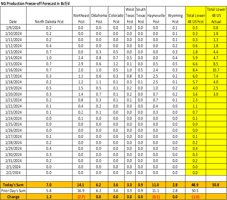Introduction Oil and gas production is a system, like any other. It ends with product out of the...
DTILs, What to Expect for 2025
|
Although natural gas prices have decreased significantly over the past month, we believe the current time spreads are insufficient for producers to consider DTILing their wells. DTILing, or delaying turning in line wells, is a strategic practice where producers complete (or frack) a drilled well but intentionally delay bringing it to sales, or TILing, until a future date. Natural gas producers typically choose to DTIL a completed well when future delivery prices are considerably higher than immediate or next-month delivery prices, creating an economic incentive for the delay. The market pricing environment for natural gas in 2024 presented precisely such a scenario, making it economically advantageous for producers to defer TILing wells.
As seen in the chart above, throughout 2024 the NYMEX January to front month ratio, defined as the NYMEX NG January 2025 contract price divided by the front month NYMEX NG contract price, peaked at 120% in late February. This meant that producers could defer TILing their wells for an additional nine months and realize more than double the immediate post-completion price for their gas. This market dynamic led to the widespread adoption of the DTIL strategy by producers in 2024, notably by the largest natural gas focused operators, EQT and Expand Energy. Hyperion data, which tracks both well completion through our fracking dataset and TIL dates through our DTIL dataset, shows that both EQT and Expand Energy initiated the DTIL process in 2024. |
|
As can be seen in the chart above, the average number of days between completion and TIL for EQT's and Expand Energy’s well pads increased dramatically. In 2023, the average delay was under 50 days. However, in 2024, this delay surged to as high as 363 days. This substantial increase directly correlates with the peak in the NYMEX NG January to front month ratio of 120%. This correlation, visible in Hyperion data, clearly demonstrates the strong economic rationale behind EQT's and Expand Energy’s full-scale adoption of the DTIL strategy. We expect this relationship to hold going forward and believe that, in general, gas producers' propensity for DTILing can be approximated with the January to front month ratio.
The current January to front month ratio of approximately 60% does not suggest an imminent return to DTIL practices. However, close monitoring of both the NYMEX NG January to front month ratio and the duration for which completed well pads remain un-TILed is crucial. A rising trend in the number of days before TIL, coupled with a rapidly increasing January to front month ratio, would signal a potential shift back to DTIL practices by natural gas producers. A recurrence of the 2024 DTIL trend could have significant implications for the natural gas market, potentially leading to price volatility and near-term supply disruptions. For producers, implementing DTIL strategies impacts cash flow, hedging strategies, and overall business planning. The Hyperion DTIL dataset allows for the early identification of these trends before public announcements from natural gas producers. Conclusion The practice of Deferred Turning-In-Line (DTIL) by natural gas producers is directly tied to the forward natural gas curve. In 2024, a high NYMEX January to front month ratio incentivized major producers like EQT and Expand Energy to significantly delay TILing their wells. This trend, identified through Hyperion data, had notable impacts on the market. While we believe that current market conditions do not favor a return to DTILs, continuously monitoring the NYMEX ratio and TIL delays through the DTIL dataset is essential to catching this potential change in behavior early. |





